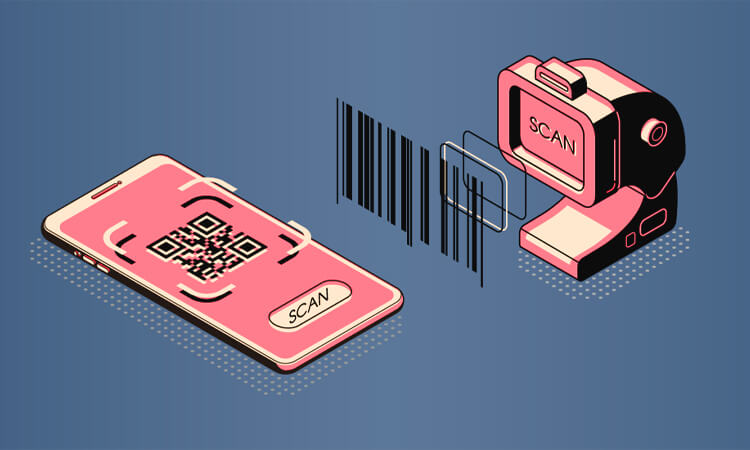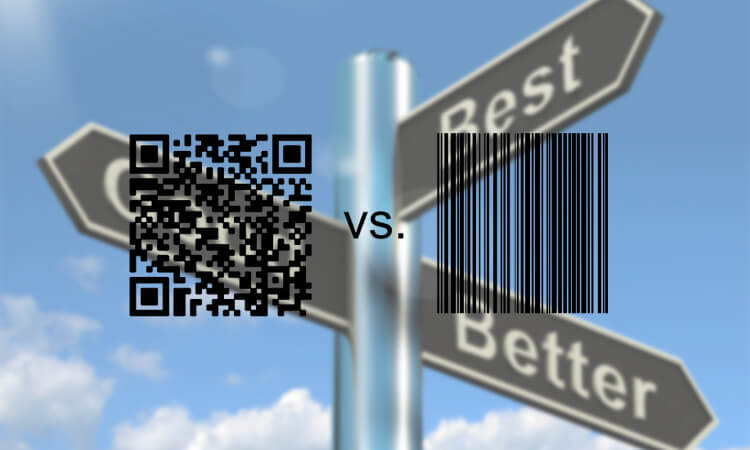QR Code vs Barcode – the two most common forms of automatic identification. QR codes and barcodes have long been used to quickly and accurately identify products or items. But what are the differences between them? Let’s take a closer look.
QR Code vs Barcode: History
The history of barcodes and Quick Response Codes (QR codes) goes back decades. People used the first barcodes in retail stores in the late 1960s. QR codes first appeared in 1994. People originally developed QR codes to facilitate efficient data processing in the automotive industry. More industries began to see it incorporated later, such as marketing and healthcare.
Definition of QR Codes and Barcodes
QR Code vs Barcode: What is a QR Code?
QR (or Quick Response) codes are two-dimensional barcodes. It is primarily used to store information such as URLs, contact information, and other data. They can be scanned with a smartphone or other device. This makes it a convenient way to share information. A QR code can hold more information than a barcode. Most businesses will use it to track user activity and store information.
Read More: QR Code Test: Everything You Need To Know
Barcode vs QR Code: What is a Barcode?
A barcode is a linear, one-dimensional representation of data. It usually consists of a series of black bars and white space. It requires a barcode scanner to read the encoded data. The most common barcode type is the Universal Product Code (UPC). The UPC is a 12-digit code used to identify store items. The code can contain various information about the item, such as manufacturer, product type, etc. Barcodes are used in a variety of different industries. The retail industry typically uses it to track inventory. The medical industry uses it for patient management and billing. It is also used for manufacturing quality control and government taxation and identification.
QR Codes vs Barcodes: They are Difference

- The Difference in Data Capacity
One of the main differences between QR codes and barcodes is their data capacity. QR codes can store up to 7,000 characters of data, while barcodes can only store up to 20 characters. It means that QR codes can store more information than barcodes. This difference makes QR codes more versatile and useful in various industries.
- Cost
Barcodes are less expensive than QR codes. Barcodes are printed on labels and can be read by barcode scanners. 2D codes are more expensive because they require additional software and hardware for encoding and decoding. Barcode readers are also relatively inexpensive compared to 2D code readers.
- Security
Barcodes are more secure than QR codes. This is because they can be encrypted, making them difficult to copy. On the other hand, QR codes are not encrypted and can be easily copied.
- Versatility
QR codes are more versatile than barcodes. They can store and display text, images, URLs, and other information. Barcodes are limited to displaying text and numeric data.
- Readability
Barcodes are easier to read than QR codes. Barcode scanners from any angle and distance can read them. However, QR codes require a smartphone camera and are difficult to read in dim light or if the code is corrupted.
- Scanning Methods
QR codes are much easier to scan than barcodes. Barcodes require a laser scanner, while QR codes are scanned with a camera. It means that QR codes can be scanned using the cameras of smartphones and tablets. Barcodes, on the other hand, require a special scanner.
- Ease of Use
Barcodes are often easier to use in certain situations. For example, when you need to scan data quickly and accurately. This is because barcodes are designed to be scanned with a laser. Laser scanning allows them to be read quickly and accurately. On the other hand, QR codes require a camera and software to “read” their data. This type of scanning can take much longer.
Barcode vs QR Code: Which is Better?

Both barcodes and QR codes have their advantages and disadvantages. Whether one is “better” than the other depends on the specific use case.
Barcodes are a simple and cost-effective way to store and retrieve data. They have been used for decades and are widely supported by scanning devices. They are commonly used for inventory management and product tracking in the retail and manufacturing industries.
QR codes have some additional features that make them even more versatile. The advantages of QR codes make them very useful in mobile applications. They are often used for mobile payments, digital marketing, and other applications. In these applications, the ability to scan the code using a smartphone is an advantage.
In terms of design, QR codes can be designed in different forms, styles, and colors. This helps make the codes more attractive and attention-grabbing. This feature makes it useful for advertising or campaigns.
This table describes the difference between QR codes and barcodes:
| Feature | QR Code | Barcode |
|---|---|---|
| Appearance | Square shape with black and white modules arranged in a pattern | Rectangular shape with a series of parallel lines of varying thickness |
| Storage capacity | Can store more data, such as URLs, text, and images | Can only store a limited amount of data, typically a product code or number |
| Reading speed | Can be read quickly and from different angles | Must be read in a specific orientation and at a certain distance |
| Applications | Commonly used for marketing and advertising, ticketing, and payments | Widely used for inventory management and retail product identification |
| Reader technology | Requires a smartphone or QR code scanner app to read | Can be read by a barcode scanner or smartphone camera |
| Error correction | Includes built-in error correction, allowing for some damage or distortion without losing data | Does not have built-in error correction, meaning any damage or distortion may cause the data to be unreadable |
Overall, barcodes are very reliable for applications where codes are scanned with traditional barcode scanners. QR codes offer more flexibility and functionality. It is useful for mobile and digital applications.
QR Code vs Barcode: The Difference between Scanners
QR scanners and barcode scanners have some similarities but also key differences:
Similarities:
- They are both tools for reading visual codes that contain digital information. Barcodes contain rows of black bars and white spaces, while QR codes contain a 2D grid of dots.
- They can access web links, contact info, product details, or other encoded data.
Differences:
- Barcode scanners can only read 1D linear barcodes, while QR scanners can read 2D QR codes and some 2D barcode types. QR codes can contain much more data than traditional barcodes.
- Barcode scanners typically require line-of-sight scanning and precise alignment to scan barcodes. QR scanners often have wider scan areas and can scan QR codes from a greater viewing angle.
- Barcode scanners are typically simpler, more compact, and lower cost. QR scanners tend to be larger and more advanced, targeting business and developer use cases.
- Barcode scanners often rely on wired or serial connections, while many QR scanners also support wireless Bluetooth and USB connectivity.
In addition to QR code barcodes, you have other options: Alternative to QR Code
What are the Disadvantages of QR Codes Compared to Traditional Barcodes?
While QR codes have gained popularity due to their ability to store more data and provide interactive experiences, they have disadvantages compared to traditional barcodes.
- First, QR codes require a smartphone or other device with a camera and a QR code scanning app, whereas traditional barcodes can be scanned with a simple barcode scanner. This requirement can limit accessibility for some users.
- Second, QR codes are more complex and difficult to print and scan accurately.
- Third, QR codes are not as widely recognized as traditional barcodes, confusing some users.
- Finally, QR codes can be easily manipulated or hacked, making them vulnerable to security threats.
Despite these disadvantages, QR codes are used in various applications due to their unique capabilities.
Uses of QR Codes and Barcodes
Some common applications of QR codes include:
- Product tracking and inventory management in the retail and manufacturing industries
- Mobile payments and digital wallets
- Digital marketing and advertising
- Event ticketing and registration
- Contactless access control, such as building access or public transportation
The use of barcodes is generally more limited. It is mainly used in retail and manufacturing, supermarkets, and logistics.
Barcode scanning devices are usually cheaper than QR code scanners. Therefore, you can find them in many small businesses and supermarkets.
QR Code vs Barcode: When to Use Them?
- Barcodes are best used when storing a small amount of data. For example, you need to store the SKU or ISBN of a product.
- QR codes are suitable when storing more data, such as URLs, text, or contact details.
- Barcodes are also better suited for situations where you need to read the code quickly, such as at the checkout counter in a store.
- QR codes are more versatile. You can use it for various applications, such as marketing, inventory management, and tracking.
Related Reading: Sample QR Codes for Testing Types
Can QR Codes Replace Barcodes?
QR codes have advantages over traditional barcodes that make them more versatile. It is useful for some applications, but it is unlikely that QR codes will completely replace barcodes.
QR codes have more storage capacity than traditional barcodes and can be scanned with a smartphone’s camera. This makes them useful for mobile applications. They are often used for mobile payments, digital marketing, and other applications. The ability to scan codes using a smartphone is an advantage in these applications.
However, barcodes are still widely used in many applications. They have proven to be a simple and reliable solution. They are commonly used in retail and manufacturing industries for inventory management and product tracking. They are also widely supported by scanning devices. Its simplicity and low cost make them well-suited for small businesses.
In addition to this, barcodes can be printed and scanned at high speeds. This makes them suitable for high throughput applications, such as supermarkets and logistics centers.
So, QR codes can provide additional functionality and flexibility, but barcodes are still well-suited for many applications. In most cases, QR and barcodes can co-exist and complement each other.
Can Barcode Readers Read 2D Codes?
Some barcode readers can read 2D codes, such as QR codes. While the term “barcode reader” is usually associated with linear one-dimensional barcodes. However, many barcode readers today also include the ability to read 2D codes.
2D barcode readers use a different scanning technology than traditional linear barcode readers. They use a CCD (charge-coupled device) or CMOS (complementary metal oxide semiconductor) image sensor to capture an image of the code. They then also use sophisticated software to decode the data. You can connect these readers to a computer or mobile device. You can also integrate them into a mobile device or smartphone.
It is important to note that 2D barcode readers can read QR codes. However, they may not be able to read all types of 2D codes such as PDF417, Data Matrix, etc. Some specialized 2D barcode readers can read different types of codes more easily. Therefore, it is important to check the capabilities of a barcode reader before purchasing one for a specific use case.
Costs of Implementing Barcode vs QR Code
The cost of implementing barcodes or QR codes can vary greatly depending on the application and implementation method. For example, the cost of printing barcodes on product labels may be low. The cost of implementing a barcoded inventory management system may be higher. Barcodes require specialized printers and software to generate, which may also add to the cost. On the other hand, you can generate QR codes for free using various online QR code generators. The cost of implementing QR codes can also vary from application to application. However, they tend to be more expensive than barcodes. This is because they require a QR code reader or a smartphone with QR code scanning capabilities.
Both QR codes and barcodes are useful tools for quickly and accurately identifying products or items. QR codes are more versatile and secure than barcodes but require specialized hardware to use effectively. Barcodes are simpler and easier to read, but they are limited in the amount of information they can store. Understanding QR code vs barcode differences can help you choose the right tool for your application.
More About QR Code vs Barcode Problem
-
What is the difference between a QR code and a barcode?
A barcode is a series of vertical bars of different widths and spaces that represent data. On the other hand, a QR code is a two-dimensional code made up of black and white squares arranged in a specific pattern. QR codes can store more information than barcodes and can be read much faster.
-
What are the advantages of using QR codes over traditional barcodes?
QR codes can store more data than traditional barcodes and can be read much faster. They also offer more flexibility in terms of design and can be customized with logos and colors.
-
How do QR codes and barcodes work, and what type of information can they store?
QR codes and barcodes work by encoding data in a visual format that a scanner or smartphone camera can read. Barcodes typically store a product’s UPC or EAN code, while QR codes can store a wide range of data, including website URLs, contact information, and even videos.
-
Can QR codes and barcodes be used interchangeably, or are there specific use cases for each?
QR codes and barcodes have different strengths and weaknesses, so they are not always interchangeable. Barcodes are typically used for inventory management and product tracking, while QR codes are often used for marketing and promotional purposes.
-
How do QR codes and barcodes impact inventory management and supply chain logistics?
QR codes and barcodes can help improve inventory management and supply chain logistics by providing real-time visibility into the movement and location of products. They can also help to reduce errors and delays in shipping and receiving.
-
What are some examples of industries where QR codes or barcodes are particularly useful?
QR codes are often used in retail, advertising, and tourism, while barcodes are commonly used in manufacturing, logistics, and healthcare.
-
How are QR codes and barcodes being used in marketing and advertising campaigns?
QR codes and barcodes are used in marketing and advertising campaigns to provide customers with additional information about products, promotions, and events. They can also be used to track the effectiveness of marketing campaigns and measure customer engagement.
-
What are some common misconceptions about QR codes and barcodes?
One common misconception is that QR codes are only used for marketing, while barcodes are only used for product tracking. In reality, both technologies have a wide range of applications in various industries.
-
How do QR codes and barcodes impact consumer behavior and shopping experiences?
QR codes and barcodes can impact consumer behavior and shopping experiences by providing customers with access to additional information and promotions and making it easier to shop and make purchases.
-
What is the future of QR codes and barcodes, and how might they evolve in the coming years?
The future of QR codes and barcodes will likely involve greater integration with other technologies, such as augmented reality and the Internet of Things. They may also become more customizable and interactive, allowing businesses to create more engaging and personalized customer experiences.
-
Where should you not use QR codes?
Due to potential security risks, QR codes should not be used in sensitive settings, such as medical records or financial transactions. A study by security researchers found that malicious QR codes can lead to phishing attacks or malware downloads, which can compromise personal information. Additionally, QR codes should not be placed in locations that are difficult to scan, such as high or awkward positions, or in low-light environments where the camera may struggle to focus.
Video Source: A Singapore Government Agency Website









